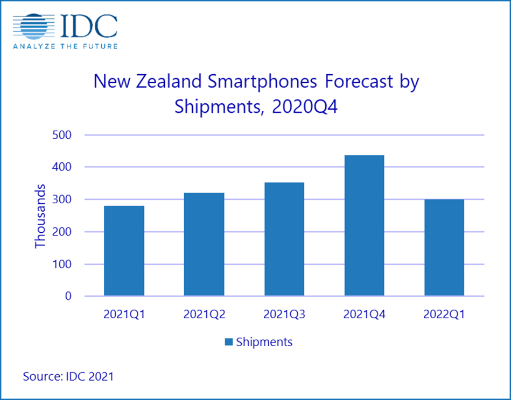Upbeat End To 2020 For NZ’s Smartphone Market, And Key Trends For 2021
The New Zealand smartphone market finished 2020 on a high, achieving annual growth in the fourth quarter, a feat not seen since Q3 of 2018. According to the latest IDC Asia/Pacific Quarterly Mobile Phone Tracker, New Zealand Smartphone shipments increased 23% QoQ to over 473,000 units, achieving annual growth of 3% YoY in 2020Q4.
The new 5G capable iPhone 12, released by Apple in Q4, was instrumental in the performance of the market as Kiwis were quick to buy the new device, with extra available discretionary income unspent on overseas travel. Retailers’ Black Friday sales and holiday deals also presented consumers with attractive prices and bundles across most phone segments, leading to heightened demand as 2020 came to an end.
“A stable macro environment has instilled greater confidence in consumer spending this quarter,” says Maxim Wilson, Associate Market Analyst for NZ Mobile Devices. A low interest rate setting continues to motivate spending in the smartphone market, after a difficult first half of 2020, in which spending was focused towards WFH devices. “Supply was more reliable in Q4 for vendors and telco channels, with the best positioned vendors those who had fulfilled orders far earlier in preparation for the busier periods in November and December.” However, as neither Apple nor Samsung tend to prioritise shipments into the Pacific region, larger Asian countries tend to get the bulk of their premium models. This has seen some NZ channels struggle to get enough inventory in to meet the demands of the most sought-after models. Some backlogs at ports, particularly in Auckland, have also delayed shipments of certain models to telco and retail channels. It is not clear currently how long these delays may last for.
Apple took the top spot in 2020Q4, accounting for over 200,000, or 43% of shipments. This came thanks to the successful launch of the iPhone 12, which was met by a positive response from consumers. The first of Apple’s 5G capable devices will begin a new era for the vendor, as Kiwis begin to embrace the next generation of models. According to IDC, 35% of total NZ smartphone devices were 5G capable in 20Q4, up from only 8% in Q3 of 2020. ‘This trend will continue as more vendors deploy these devices not just in the premium price bracket, but in more affordable categories,’ says Wilson.
Samsung accounted for 168,000 shipments, or just over one third of the market. Once again, there was a strong showing across most of their A Series price range, particularly their low to mid-price brackets. OPPO continues to be the growth story in the NZ market, bringing in 45,000 units and cementing themselves as the key challenger brand to watch for in 2021.
Vodafone remains a dynamic player in the lower, sub-NZ$200 price band, while Huawei has had a tougher time recently, as it struggles to maintain its market share due to the US sanctions. This has hampered them from producing new models with Google services.
Price bands across shipments were a standout trend this quarter. For the first time this year, the ultra-premium brand was number one, thanks to the iPhone 12 range. The NZ$1500+ segment accounted for 19% of the total market, while the mid-range fell out of top spot for the first time in over two quarters, despite accounting for 18% of total shipments, and a YoY gain of 12%.
In terms of expectations for 2021Q1, IDC is forecasting 281,000 shipments, at an annual growth rate of 15%. The quarter will look far different to the Covid effected 2020Q1, in which supply chains were overwhelmed and consumer sentiment negatively impacted. Stricter supply of models is a concern in 2021Q1, a trend mentioned below, that IDC will monitor throughout 2021.
Trends to watch for in 2021:
Shift to 5G: 5G is a major talking point in 2021 for consumers, vendors and telcos. IDC predicts that 50-55% of total NZ smartphone shipments for the year will be 5G capable, as vendors begin to offer models in more accessible price brackets, away from the premium price bracket most currently sit in.
Price bands: IDC highlights the mid-range NZ$300-$600 bracket as a favoured choice for 2021, based on the affordability of models with specs not too dissimilar to the premium brackets. A 76% YoY growth in the NZ$600-900 price bracket in 2020Q4, also illustrates Kiwis’ substitution away from premium models, a trend set to continue in 2021.
Supply/logistics: The spotlight will be on global supply chains throughout 2021, and the time and cost to freight devices into New Zealand. There have been more signs of strain lately on chip manufacturers as they become concerned about meeting vendors demands.
New brands: The impacts of COVID-19 acted as a major barrier to entry for smaller up-and-coming brands trying to penetrate the NZ market in 2020. In 2021, there should be more opportunity for brands such as OnePlus, Xiaomi, and Vivo, as they try to establish a greater presence in our market, particularly through retail channels.



 Parrot Analytics: A Very Parrot Analytics Christmas, 2024 Edition
Parrot Analytics: A Very Parrot Analytics Christmas, 2024 Edition Financial Markets Authority: Individual Pleads Guilty To Insider Trading Charges
Financial Markets Authority: Individual Pleads Guilty To Insider Trading Charges Great Journeys New Zealand: Travel Down Memory Lane With The Return Of The Southerner
Great Journeys New Zealand: Travel Down Memory Lane With The Return Of The Southerner WorkSafe NZ: Overhead Power Lines Spark Safety Call
WorkSafe NZ: Overhead Power Lines Spark Safety Call Transpower: Transpower Seeks Feedback On Electricity Investment Short-list For Upper South Island
Transpower: Transpower Seeks Feedback On Electricity Investment Short-list For Upper South Island Commerce Commission: “Cheating The System” – Sentencing In Country’s First Criminal Cartel Case
Commerce Commission: “Cheating The System” – Sentencing In Country’s First Criminal Cartel Case



